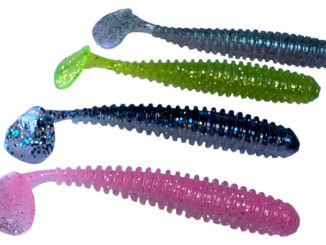
These fish will make your day when nothing else seems to be biting.
When Mike Muhlbauer’s line came tight with an abrupt strike, we were certain it was bull red time. A couple of Florida boys with a lot of ambition but just a little time, Muhlbauer and I had determined that we’d fare best at the perennial redfish magnet — Southwest Pass.
During a motor drift past the lower end of the east jetty, Muhlbauer’s bottom machine exploded with color. A load of bait and what looked like big fish roaming the waters off a point in the rocks gave us a clear target. We motored upcurrent, lined up for a focused drift and flipped out a couple of Carolina rigs baited with fresh shrimp.
Not even a minute after deployment, Muhlbauer’s big spinning rod doubled over like a willow in a hurricane. Fortunately, wind and tide kept us away from the rocks, and the fish seemed to prefer an open-water fight. A back-breaking battle ensued with several short but strong runs and a relentless tug-of-war.
Muhlbauer fought the fish around the 33-foot Hydra-Sports twice before settling at the stern for a monumental test of endurance. Murky river water concealed the fish’s identity until the fight was entirely over, and much to our dismay the auburn log that we were anticipating actually surfaced with yellow trim, a forked tail and a black dot on each cheek.
Needless to say, a 30-pound jack crevalle was far from what we had expected. Were we disappointed? Sure. Had this been a waste of time? Not at all.
Jacks won’t make many fishing calendars, and not a lot of guides list them on their business cards, but these valiant fighters feed with reckless abandon and give you all the briny battle you can stand. My fishing buddy would have undoubtedly preferred the bull red, but conquering the big, yellow brute left him with a solid sense of accomplishment.
“Now, that was a fight,” he exclaimed. “I didn’t think he’d ever give up.”
Such sentiments define the concept of “day savers” — those undervalued and underutilized fish that anglers overlook during hunts for more prestigious predators. Nothing wrong with seeking the sexy species, but the sea offers many options, and flexible fishermen can salvage a good day on the water by learning to appreciate this game’s back-up players.
Alternatives
Historically, fishing has been, is and forever will be an opportunistic sport. Planning is essential, and identifying specific targets facilitates focus. But consider John Lennon’s timeless observation: “Life is what happens while you are making other plans.”
For anglers, that means keeping your mind and your eyes wide open and keeping your hands ready to capitalize on whatever wild card fate deals you. Consider a football team whose star quarterback gets his bell rung and staggers off the field unfit to play. Does the coach forfeit the game, or does he send Joe Benchwarmer in for a few snaps until the starter’s ready to go?
Let’s face it: Fishing — particularly offshore pursuits — is not cheap. Fuel costs alone necessitate prudent planning, and maximizing one’s time on the water now carries clear economic undertones. Even when fat wallets mean liberal budgets, how much is your time worth? Taken that way, not many of us can afford fruitless trips.
Several species can fill in the time with rod-bending fun whenever big-name fish play hard-to-get. Sometimes, the targeted species like redfish, trout, tuna, snapper, etc. just don’t cooperate, but do you blow off the day and return to port grumbling about wasted time and fuel? No way. Just look around, and you can almost always find something with an appetite.
Consider a few other examples in which “B-teamers” can carry the ball for great fishing fun.
Phony footballs
Few sights thrill offshore anglers like that of leaping tuna. “Footballs in the air,” is the common exclamation.
It’s good when you find active tuna, but the same crankbaits, cedar plugs, jet heads and rigged ballyhoo that you pull for the sushi pigs will also tempt any bonito in the area. Often mixing with tuna, the fish known as little tunny strike fast and run hard — a good warm up for the stars of the show.
Catching bonito is practically an assumption during tuna missions, but when yellowfin and blackfin play hard-to-get, the silver bullets seldom exhibit such coy behavior. Strategically, this can work in your favor, as pelagic fish frequently find their meals by homing in on the sights, sounds and vibrations of other predators. Particularly when you set up a chum line, gluttonous bonito can actually attract tuna and other predators to the party.
For big-game pursuits, freshly caught little tunny make tempting baits for marlin and big wahoo. If a tuna mission falters, consider switching gears and making good use of cooperative bonito.
Platform panfish
For years, I had assumed that the clouds of chunky bodies I would see circling a drilling rig were hardtails (blue runners). Some are, but during a recent trip with anglers Les Collins and Jeffrey Parrish, an unproductive afternoon of rig trolling had us looking hard for a good string-stretching opportunity.
With hundreds of figures moving en masse around the deep-water rig, Collins mused: “I wonder if those fish will eat?”
Itching to crank a reel, he cut the sabiki rig off one of his bait rods, tied on a small hook and impaled a pogy chunk. As soon as his bait hit the water, Collins saw dozens of bodies converge on the morsel. Whatever these ravenous fish were, their feeding aggression was so intense that they literally bumped one another away from the meat.
Eventually, one of the schoolies got its mouth around the bait, and Collins came tight on a plump, elliptical bodied fish that we later identified as a Bermuda chub. With a seemingly endless supply of 3- to 7-pounders, we could have caught these fish until we ran out of bait, but we decided to leave them biting. (We’re sportsmen, after all.)
Double drumming
In this case, an alternative species plays a complementary role more so than one of replacement. Black drum, those homely and heavy-set cousins of the redfish, often bolster the action for their famous relatives. The darker drum is more often taken on natural baits, but jigs and swimbaits also interest these fish.
Striped interlopers
Probing the points and cuts of a delta marsh usually fosters expectations of redfish, trout and the occasional flounder. Sheepshead rarely top the objective list, but their presence is unavoidable, their abundance undeniable. Nevertheless, the fish in the convict suit gets little love for its sporting value.
Such was not the case on a recent inshore trip with Parrish, Collins and Muhlbauer. The big old bunch of us out-of-towners were working the Redfish Bay marsh, and stumbled into a pile of hefty sheepshead that repeatedly beat local redfish and trout to the shrimp we had floating beneath rattling cork rigs.
We gladly welcomed the other game fish, but with clearly motivated sheepshead — many in the 7-pound range — outpacing competitors that were apparently napping on the job, we kept bending rods with no complaints.
Although our local hosts, Capt. C.T. Williams and Jimmy Fisackerly, expressed their disdain for sheepshead, Parrish noted that anglers in his home state of North Carolina highly regard the species.
“On the East Coast, people go crazy for big sheepshead like this,” he said.
Everyone’s entitled to his opinion and preference, but a bent rod is a bent rod. Still, there exists a lingering aversion to “trash fish,” as they’re often called. For the naysayers among us, here are a few more reasons why alternative species deserve a chance to prove themselves:
• Entertaining kids.
Young anglers rarely possess the patience needed for locating and engaging many of the big-name game fish, but plug them into the easier targets, and you’ll entertain them for hours. The key with kids is constant stimulation, and a morning spent winding in alternative species can make you the hero a lot faster than a day-long hunt for a single trophy fish.
• Educating novices.
This one’s all about the pressure. Few tasks match the futility of trying to get an inexperienced angler to listen and perform while the fish of his dreams is taking him to school. When the stakes are high, adrenalin overrides awareness and technique suffers. However, when an angler ties into a fish that he’s not all that worried about losing, performance anxiety lessens and instructions fall on receptive ears.
• Practice makes perfect.
Simply put, precision is born of repetition. Polish your approach and presentation with species of greater abundance, and you’ll sharpen your skills for A-team.
Whatever second-string fish you end up pursuing, remember the same logic you followed into your current rod-bending bliss can also lead you right back to your initial objective. Maybe it’s a tide change, solunar period or improvement in water conditions (temperature, clarity, etc.) that flips the switch for game fish. Regardless, pay attention to the day’s developments, and remain ready to shift your focus back to the top-shelf predators.
Sometimes they’re the appetizer, sometimes the main course. In any case, give alternative species their due respect, and you’ll savor the flavor of a successful angling venture.


